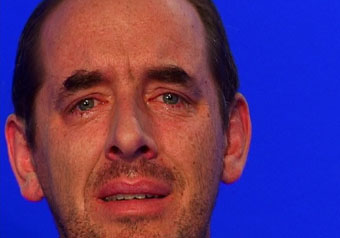 |
Lyndal Jones, Crying Man, 2003 Courtesy Anna Schwartz Gallery |
During my pre-Christmas visit to Kings artist-run studio in Melbourne, Lee loaded me up with videos, a DVD of Projekt#1-6 and the URL for the Projekt website (www.projekt.com.au). For the first time I coveted my neighbour’s home theatre. The ability to move between works, DVD, video and the website make this archive versatile and accessible. While the archive in no way replicates the experience of the work in the gallery space, as envisioned by the artist (and this certainly affects those video pieces which have been exhibited as site specific installations such as David Noonan and Simon Trevaks’ SOWA), it does enable a different and interactive engagement. It establishes a context in which to think about the work that video does.
For Lee, video art begins and ends with a question, whereas film tends to be self-contained and plot-driven. He feels that video or video art’s relationship to film is like comparing a poem to pop music. While poetry is intended to make you think and reflect, pop music offers pure distraction. This assessment is borne out in several videos which take the video clip as an incitement for their work. Kate Murphy’s Britney Love draws on her own and the fictional 11 year-old Brittany Love’s fascination with Britney Spears to reveal the incongruous relationship between highly sexualised pop video clips and their primary audience: young, mainly female viewers. In the production, young Brittany performs a highly evocative and sexualised dance routine to Crazy as she reveals her total preoccupation with a kid’s life: school, Spears and her hopes and dreams. In their video, Versus (Projekt#3), The Kingpins also draw on the conventions of the music video clip, using irony and parody to reinterpret traditional stereotypes within a cross-section of music genres. Although critiquing these constructions, the artists betray their own debt to the genre. Unlike the video clips they imitate, The Kingpins see themselves as “cheap imitators, simulating pop icons and pillaging media stereotypes, giving birth to their own reinventions.”
In Lyndal Jones’ Crying Man 1 (2003), the questioning nature of video is shown at its starkest. This work offers no narrative or resolution to the puzzle of why this particular man is crying. Here, as Jones explains, “there is no background that could anchor the tears in a particular incident, no words spoken that could explain the situation, no music to manipulate our emotions or our actions. We are free to watch him cry, to stop him or to leave.” Similarly, Alex Gawronski uses minimal means to achieve a gravity of situation. In Territory, Gawronski uses the medium to explore the covert relationship between art and war. While nothing really happens, he creates a palpable tension through his use of viewpoint, slowed down action and selective references to formalist traditions—banners, flags, uniforms and ritual—in the lead up to a political procession.
A feature of much of the work included in this archive is the simplicity of technique and approach. In contrast with what Keely Macarow (RT 54, p22) has termed the “cyberish polish invested in much ‘new’ media art”, many artists in this collection seem more interested in exploiting the gritty low-tech potential of video to raise questions. Leslie Eastman’s Erasehead (Projekt#5) and Daniel von Sturmer and Meri Blazevski’s Driveway Sequence (Projekt#5) are both successful precisely because of their awkwardness. In comparison, Alysa McHugh’s Suspension (Projekt#4) makes use of a sophisticated and self-conscious film noir technique, while Laresa Kosloff offers refined simplicity in Swell (Projekt#2).
All the works included in Lee’s archive have been shown previously in either private or public galleries in Australia. In a sphere where artists are closely aligned with galleries, Lee had to deal with the sensitive issue of protecting both artists’ and gallery rights. In negotiations with the galleries, Lee made it clear the Projekt was not selling the copyright or artist’s right and that a major spin off from the archive was promotional. As part of the arrangement with the galleries, Lee undertook to send the archive to every curatorial institution in Australia and promote it overseas. The scope of his vision, his charisma and enthusiasm, the promise of national and international exposure (for both artists and galleries) and the tangible results, overcame any concerns that the galleries might have had and they’ve enthusiastically supported the archive.
Lee’s next entrepreneurial venture is to make money for these video artists. As he sees it, art buyers will invest in photographs or video stills, yet still don’t really know what to do with video. At the forthcoming Melbourne Affordable Art Fair, Lee plans to circumvent such buyer resistance—buy a photograph or framed video still and get a DVD of the video.
In offering an archive of contemporary video work, Projekt introduces video to wider audiences in a way that is no longer dependent on the gallery context. It also provides a rich historical and educational resource for artists and scholars. One can only hope that ongoing funding will be found to enable the growth of this valuable resource. However it will not be able to rely on the restless and irrepressible energy of Brendan Lee. He has other plans and projects including his own video work. He will be participating in VideoSpell 3 Reanimate at Performance Space, Sydney from February 25 this year.
Projekt 1-6, quarterly video catalogue, DVD; curator Brendan Lee
Barbara Bolt is a Lecturer in Visual Media at the University of Melbourne.
RealTime issue #59 Feb-March 2004 pg. 33
© Barbara Bolt; for permission to reproduce apply to [email protected]








 back
back